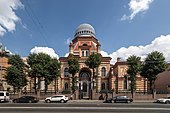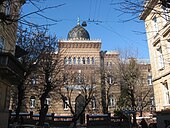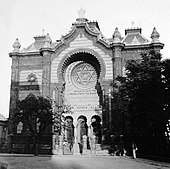Moorish Revival architecture
This article needs additional citations for verification. (December 2007) |
Moorish Revival or Neo-Moorish is one of the exotic revival architectural styles that were adopted by architects of Europe and the Americas in the wake of Romanticist Orientalism. It reached the height of its popularity after the mid-19th century, part of a widening vocabulary of articulated decorative ornament drawn from historical sources beyond familiar classical and Gothic modes. Neo-Moorish architecture drew on elements from classic Moorish architecture and, as a result, from the wider Islamic architecture.[1]
In Europe
The "
By the mid-19th century, the style was adopted by the

In Spain, the country conceived as the place of origin of Moorish ornamentation, the interest in this sort of architecture fluctuated from province to province. The mainstream was called

Although
exemplified the continuing development of the style.In Hungary
In the Balkans
Another exception was
Other notable example in the region is the building of the Regional historical museum in Kardzhali, Bulgaria build in the 1920s, combining also Central Asian styles.

In the United States

In the United States,
The trend continued into the early 1900s, for example in the 1909
In India
- Spanish Mosque, built by Viqar-ul-Umra at Hyderabad.
Theaters
In the United States
| Theater | City and State | Architect | Date |
|---|---|---|---|
| Alhambra Theatre | El Paso, Texas | Henry C. Trost | 1914 |
| Alhambra Theatre | Evansville, Indiana | Frank J. Schlotter | 1913 |
| Alhambra Theatre | Birmingham, Alabama | Graven & Maygar | 1927 |
| Alhambra Theatre | Hopkinsville, Kentucky | John Walker | 1928 |
Alhambra Theatre
|
San Francisco, California
|
Miller and Pflueger | 1925 |
| Altria Theater | Richmond, Virginia | Marcellus E. Wright Sr., Charles M. Robinson | 1927 |
| Bagdad Theatre | Portland, Oregon | Thomas & Mercier | 1927 |
| The Carpenter Center | Richmond, Virginia | John Eberson | 1928 |
| Civic Theatre | Akron, Ohio | John Eberson | 1929 |
| Corn Palace | Mitchell, South Dakota | Rapp and Rapp | 1921 |
| Emporia Granada Theatre | Emporia, Kansas | Boller Brothers | 1929 |
| Fox Theatre | Atlanta, Georgia
|
Mayre, Alger & Vinour | 1929 |
| Fox Theatre | North Platte, Nebraska | Elmer F. Behrens | 1929 |
| Granada Theater | The Dalles, Oregon | William Cutts | 1929 |
| Irem Temple | Wilkes-Barre, PA | Olds, Fred & Puckey, Willard F. | 1907 |
| Keith's Flushing Theater | Queens, New York
|
Thomas Lamb | 1928 |
| Olympia Theater | Miami, Florida
|
John Eberson | 1926 |
| Liberty Theatre | North Bend, Oregon | Tourtellotte & Hummel | 1924 |
Lincoln Theater
|
Los Angeles, California
|
John Paxton Perrine | 1927 |
| Loew's 72nd Street Theatre | New York City | Thomas W. Lamb | 1932 (dem.) |
The Majestic Theatre
|
San Antonio, Texas
|
John Eberson | 1929 |
| Mount Baker Theatre | Bellingham, Washington | Robert Reamer | 1927 |
| Murat Theatre at Old National Centre | Indianapolis, Indiana
|
Oscar D. Bohlen | 1910 |
| Music Box Theatre | Chicago, Illinois
|
Louis J. Simon | 1929 |
| New York City Center | Manhattan, New York City | Harry P. Knowles and Clinton & Russell | 1922 |
| Palace Theatre | Canton, Ohio | John Eberson | 1926 |
| Paramount Theater | Abilene, Texas | David S. Castle & Co. | 1930 |
| Plaza Theatre | El Paso, Texas | W. Scott Donne | 1930 |
| Saenger Theater | Hattiesburg, Mississippi | Emile Weil | 1929 |
Shrine Auditorium
|
Los Angeles, California
|
Lansburgh, Austin and Edelman | 1926 |
| Sooner Theatre | Norman, Oklahoma | Harold Gimeno | 1929 |
| Temple Theatre | Meridian, Mississippi | Emile Weil | 1927 |
| Tennessee Theatre | Knoxville, Tennessee | Graven & Mayger | 1928 |
| Tower Theatre | Los Angeles, California
|
S. Charles Lee | 1927 |
Village East Cinema
|
Manhattan, New York City | Harrison Wiseman; Willy Pogany (interior) | 1926 |
Around the world
| Theater | Photo | City and State | Country | Architect | Date |
|---|---|---|---|---|---|
Tbilisi Opera and Ballet Theatre
|

|
Tbilisi | Georgia | Victor schröter | 1851, rebuilt 1896 |
| Bains Dunkerquois | 
|
Dunkerque
|
France | Louis Gilquin | 1896 |
| Odesa Philharmonic Theater | 
|
Odesa | Ukraine | Alexander Bernardazzi | 1898 |
| State/Forum Theatre | 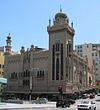
|
Melbourne, Victoria
|
Australia | Bohringer, Taylor & Johnson | 1929 |
| Civic Theatre | 
|
Auckland | New Zealand | Charles Bohringer and William T. Leighton | 1929 |
Synagogues


Europe
- Munich synagogue, by Friedrich von Gärtner, 1832 was the earliest Moorish revival synagogue (destroyed on Kristallnacht)
- Semper Synagogue, by Gottfried Semper, Dresden, 1839–40 (destroyed on Kristallnacht)
- Leopoldstädter Tempel, Vienna, Austria, 1853–58 (destroyed on Kristallnacht)
- Dohány Street Synagogue, Budapest, Hungary, 1854–1859
- Gottschedstrasse, destroyed on Kristallnachtin 1938)
- Glockengasse synagogue, Cologne, Germany, 1855–61 (destroyed on Kristallnacht)
- New Synagogue by Eduard Knoblauch, Berlin, 1859–1866
- New Synagogue, Ostrów Wielkopolski, Poland, 1857–1860
- Tempel Synagogue, Cracow, Poland, 1860–62
- Cetate Synagogue, Timişoara, Romania, by Ignaz Schumann, 1864–65
- Choral Temple, Bucharest, 1864–1866
- Zagreb Synagogue, 1867
- The Great Synagogue of Stockholm, Sweden, by Fredrik Wilhelm Scholander, 1867–1870
- Synagogue of Besançon, France, 1867–1870
- Spanish Synagogue, Prague, 1868
- Rumbach Street synagogue, Budapest, Hungary, 1872
- Czernowitz Synagogue, Chernivtsi, Ukraine, 1873
- Great Synagogue of Florence, Tempio Maggiore, Florence, Italy, 1874–82
- Princes Road Synagogue, Liverpool, England, 1874
- Sephardic synagogue, Manchester, England, 1874
- Vercelli Synagogue, Vercelli, Italy, 1878
- Vrbové synagogue, Vrbové, Slovakia, 1883
- Turin synagogue, Italy, 1884
- Great Synagogue in Pilsen, Pilsen, Bohemia, Czech Republic, 1888
- St. Petersburg, Russia, 1888
- Esztergom Synagogue, Hungary, 1888
- Lipot Baumhorn, 1889
- Rosenberg synagogue, Olesno, Poland, 1889 (destroyed on Kristallnacht in 1938)
- La Ferté-sous-Jouarre synagogue, France, 1891
- Hollandse Synagoge, Antwerp, Belgium, 1893
- Second Luxembourg Synagogue, Luxembourg City, Luxembourg, 1894
- Great Choral Synagogue (Kyiv), Ukraine, 1895
- Opava synagogue, Czech Republic, 1895
- Olomouc Synagogue, Olomouc, Czech Republic, 1897 (destroyed in 1938)
- Prešov synagogue, Prešov, Slovakia, 1898
- Košice synagogue, Košice, Slovakia, 1899, interior of Rundbogenstil building
- Malacky synagogue, Slovakia, 1886, rebuilt 1900
- Sarajevo Synagogue, 1902
- Karaite Kenesa, Kyiv, 1902
- Jubilee Synagogue, Prague, Czech Republic, 1906
- Groningen Synagogue, Groningen, Netherlands, 1906
- Choral Synagogue, Minsk, Belarus, 1906
- Bet Israel Synagogue, Belgrade, Serbia, 1908.
- Sofia Synagogue, Sofia, Bulgaria, 1909
- Galitska Synagogue, Kyiv, Ukraine, 1909
- Uzhhorod Synagogue, Uzhhorod, Ukraine, 1910
- Chișinău Choral Synagogue, Moldova, 1913
- Arabian House (Hotel Jadran) Skopje, North Macedonia, 1936–38
United States

- Plum Street Temple, Cincinnati, Ohio, 1865
- Congregation Rodeph Shalom, Philadelphia, 1866 (no longer standing)
- Temple Emanu-El on Fifth Avenue at 43rd Street, Congregation Emanu-El of the City of New York built in 1868, designed by Leopold Eidlitz, assisted by Henry Fernbach, (no longer standing)
- B'nai Sholom Temple, Quincy, Illinois, 1870
- Central Synagogue, Upper East Side, Manhattan, New York, 1872
- Vine Street Temple, Nashville, Tennessee, 1874
- Charter Oak Temple (Congregation Beth Israel), Hartford, Connecticut, 1876
- Temple of Israel, Wilmington, North Carolina, 1876[10]
- B'nai Israel Synagogue (Baltimore), Maryland, 1876
- Owensboro, Kentucky, 1877
- Prince Street Synagogue(Oheb Shalom,) Newark, New Jersey, 1884
- Eldridge Street Synagogue, Lower East Side, Manhattan, New York, 1887
- Congregation Beth Israel of Portland, Oregon, 1888 (no longer standing)
- Park East Synagogue, Upper East Side, Manhattan, New York, 1889
- Port Gibson, Mississippi, 1891
- Temple Emanu-El (Helena, Montana), 1891[11]
- Corsicana, Navarro County, Texas, 1898–1900
- Temple Sinai (Sumter, South Carolina), 1912
- Young Israel of Flatbush, Midwood, Brooklyn, 1923[12]
- Ohabei Shalom, Brookline, Massachusetts, 1925
- Congregation Ohab Zedek, Upper West Side, Manhattan, New York, 1926
- Congregation Rodeph Shalom, Philadelphia, 1928
Latin America
- Sephardic Temple, Barracas district, Buenos Aires, Argentina
- Palacio Arabe, downtown Mar del Plata, Argentina, 1945
Churches and cathedrals
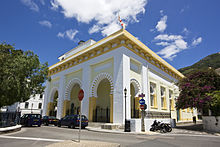
- The Cathedral of the Holy Trinity, Gibraltar (1825–1832) an early example of Moorish revival architecture is located in Gibraltar, which formed part of Moorish Al-Andalus between 711 and 1462 AD.
- Immaculate Conception Church (New Orleans), (a.k.a. Jesuit Church) is a striking example of Moorish Revival Architecture. Across the street was the College of the Immaculate Conception, housing a chapel with two stained glass domes. The chapel was disassembled and about half of it (one of the stained glass domes, eleven of the windows) was installed in the present Jesuit High School.
Shrines and temples

The Shriners, a fraternal organization, often chose a Moorish Revival style for their Temples. Architecturally notable Shriners Temples include:
- Acca Temple Shrine, Richmond, Virginia, currently Altria Theater, formerly 'The Landmark Theater' and 'The Mosque'
- Algeria Shrine Temple, Helena, Montana
- Almas Temple, Washington D.C.
- El Zaribah Shrine Auditorium, Phoenix, Arizona
- Jaffa Shrine Center, Altoona, Pennsylvania
- Jerusalem Temple, New Orleans, Louisiana, built at 1137 St. Charles Avenue in 1918 by architect Emile Weil.
- Medinah Temple, Chicago, Illinois now a Bloomingdale's.
- Murat Shrine, Indianapolis, Indiana, the largest Shrine temple in North America, now officially known as Old National Centre.
- New York City Center, now used as a concert hall
- Shrine Auditorium, Los Angeles, California
- Tripoli Shrine Temple, Milwaukee, Wisconsin
- Zembo Mosque, a Masonic Temple in Harrisburg, Pennsylvania
- The Scottish Rite Temple in Santa Fe, New Mexico, while not a Shrine Temple, is a Masonic building that uses the Moorish Revival architectural style.
- Karem Shrine Temple, Waco, Texas; now Hotel 1928
Other buildings
- Building of the Regional historical museum in Kardzhali, Bulgaria, 1922-1930
- Palace of Manguinhos, site of the Oswaldo Cruz Foundation, in Rio de Janeiro, Brazil, 1905-1918
- "Mosque" shaped steam-generation plant in Sanssouci Park, Potsdam, Prussia, 1842
- The Zacherlfabrik, Vienna, 1892
- City hall, Brcko, Bosnia and Herzegovina, 1892
- City hall, Sarajevo, Bosnia and Herzegovina, 1894
- Jewish Hospital, Lviv, Ukraine, 1900
- Mostar Gymnasium, Mostar, Bosnia and Herzegovina, 1902
- Former Yenidze Cigarette Factory, Dresden, Germany, 1908 (here, the "minarets" are used to disguise smokestacks)
- Gedung Sate, Bandung, Indonesia, 1924
- Casamaures, Saint-Martin-le-Vinoux, France, 1855
- Villa Zorayda, St. Augustine, FL, 1883
- Campo Pequeno bullring, Lisbon, 1892
- Henry B. Plant Museum, Tampa, FL, 1891
- Karlo Helmbold's House (Šeherezada), Zrenjanin, Serbia, by Ištvan Bart, 1900
- Atwater water treatment plant, Canal de l'Aqueduc, Montreal, QC, 1912–18
- Scroll and Key Hall (Yale senior society building, New Haven, CT; 1869 and 1901)
- Palacio de Valle in Cienfuegos, Cuba(1913–17)
- The Citadel, a military college in Charleston, South Carolina
Gallery
-
Immaculate Conception Church (New Orleans), 1851, rebuilt 1930
-
Leopoldstädter Tempel, Vienna, Austria, 1858
-
Spanish Synagogue (Prague), Czech Republic, 1868
-
Florence synagogue, Italy, 1882
-
Turin synagogue, Italy, 1884
-
Fabric New Synagogue in Timişoara, Romania, 1889
-
Tampa Bay Hotel, Tampa, Florida, 1891
-
TheSt. Petersburg, Russia, 1893
-
Great Synagogue, Plzeň, Czech Republic, 1893
-
The Palace of Manguinhos in Rio de Janeiro, Brazil
-
Likani Palace, Georgia, 1895
-
Arseny Morozov House, Moscow, Russia, 1899
-
Former Jewish Hospital in Lviv, Ukraine, 1901
-
Mostar Gymnasium, Mostar, Bosnia and Herzegovina, 1902
-
Uzhhorod Synagogue, 1910
-
Hotel Jadran (Arabian house) in Skopje, North Macedonia, 1938
-
Kórnik Castle, Poland
-
Scroll and Key Hall; New Haven, Connecticut (Yale senior society building). This is a proposed plan of ca. 1867. Only far left structure was built.
-
History Museum, Kardzhali, Bulgaria
See also
- Moorish Revival architecture in Bosnia and Herzegovina
- Islamic architecture
- Indo-Saracenic Revival architecture
Notes
- S2CID 99943973.
- ISBN 978-1-900289-73-3.
- ^ a b c "Why Moorish? Synagogues and the Moorish Revival". Museum at Eldridge Street. 2017-04-27. Retrieved 2019-11-17.
- ^ .
- .
- ISBN 9004128204.
- ISBN 0-471-25036-8.
- ^ Utah Division of State History (19 May 2016). "Saltair: A Photographic Exhibit". Retrieved 16 January 2023.
- ^ Gebhard, David. Santa Barbara Architecture, from Spanish Colonial to Modern. Capra Press. Santa Barbara. 1980. (later editions avail.) p. 109
- ^ "View, Temple of Israel, Wilmington, North Carolina", NC State University Libraries. Retrieved August 23, 2021.
- ^ "National Register". Archived from the original on 2012-08-03. Retrieved 2012-08-15.
- ^ BJHI Author (December 5, 2013) "Young Israel Of Flatbush", Brooklyn Jewish Historical Initiative. Retrieved August 23, 2021.
Sources
- Naylor, David (1987). Great American Movie Theaters. Washington, D.C.: The Preservation Press. ISBN 9780891331278.
- Thorne, Ross (1976). Picture Palace Architecture in Australia. South Melbourne, Australia: Sun Books Pty. Ltd. ISBN 072510225X.









